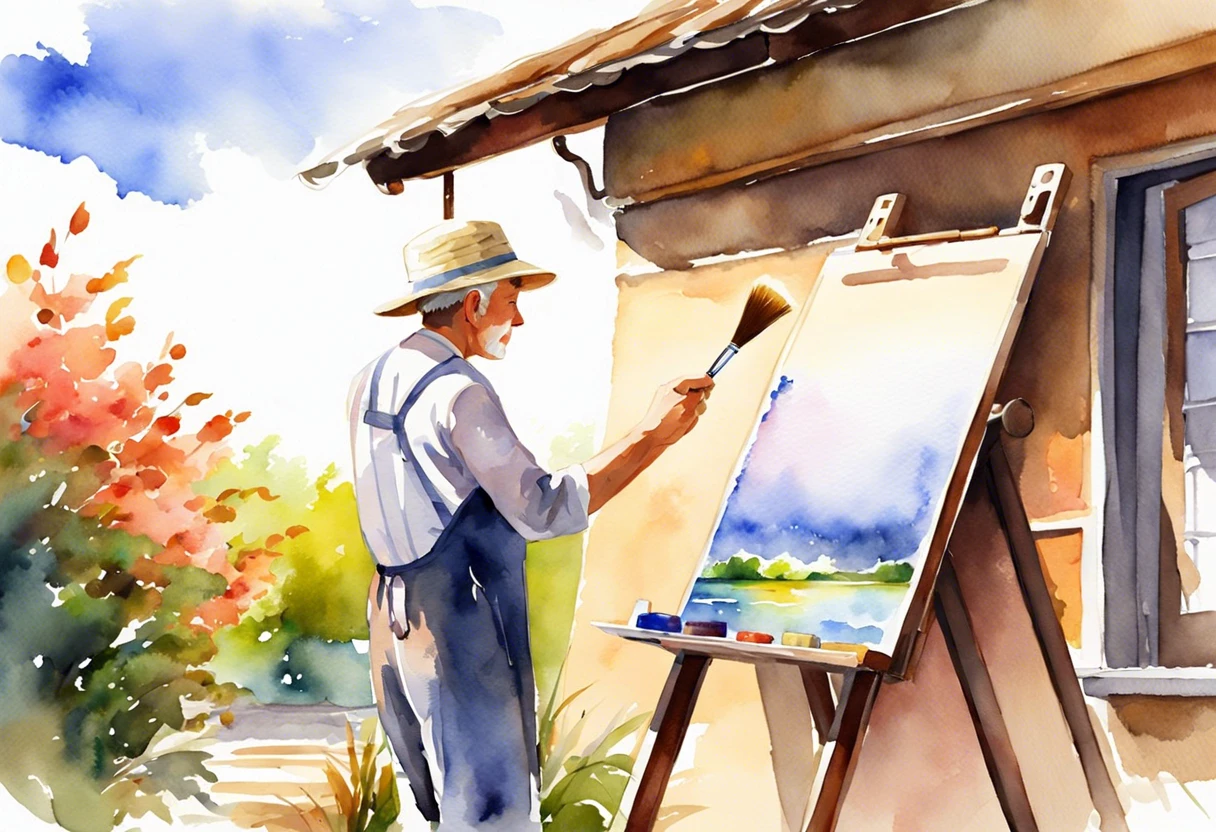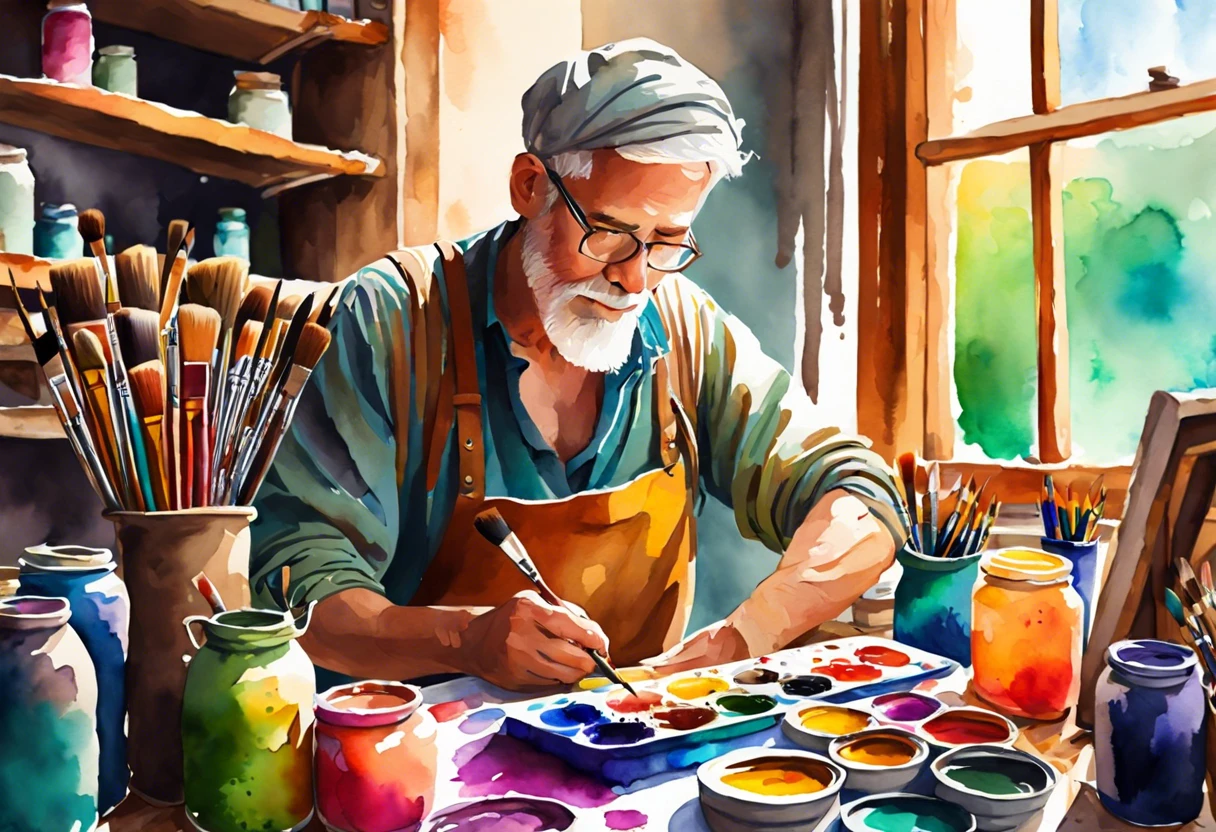What Temperature Does It Need to Be to Paint?
Published on: May 11, 2025 | Last Updated: January 7, 2025
Written By: Alisha Winters
Temperature is how hot or cold something is. It’s like when you feel warm sun on your skin or cold snow on your nose!
Knowing what temperature it needs to be to paint is super important. When I painted my living room, I learned that the right temperature helps the paint dry properly and look great.
In this guide, we’ll explore temperature basics, why you should pay attention to it, how to find the best painting temperature, and what happens if you ignore it. We’ll also discuss types of paint, drying times like how long does cabinet paint take to dry, and tips for handling temperature-related issues.
Contents
- 1 What Temperature Does It Need to Be to Paint?
- 2 What is Temperature?
- 3 Before You Start Your Painting Project
- 4 Steps to Determine the Best Temperature for Painting
- 5 Types Of Paint and Their Suitability to Temperature
- 6 Factors Affecting Paint Application and Temperature
- 7 Common Issues When Painting According to Temperature
- 8 Effects of Temperature Fluctuations on Paint Performance
- 9 Ideal Temperature Range for Different Painting Conditions
- 10 Weather Impact on Painting Conditions
- 11 Temperature-Sensitive Paints
- 12 Seasonal Considerations for Painting Projects
- 13 FAQ
- 14 Conclusion
- 15 Useful Resources
What Temperature Does It Need to Be to Paint?
You need to paint when it’s between 50°F (10°C) and 85°F (29°C). This range helps the paint dry properly. Too cold or too hot can mess with the finish. Pay attention to humidity too—ideally keep it below 70%! If you want to protect your freshly painted surface, you might want to explore clay bar paint protection techniques.
The Finishing Touch
A freshly painted wall is a blank canvas. The best way to bring your room to life is with a single piece of statement art that ties everything together.
Browse Wall Art at Big Wall DecorWhat is Temperature?
Temperature is a measure of thermal energy. It’s quantified using degrees Celsius (°C) or Fahrenheit (°F) and determines the direction of heat flow between objects.
In painting, surface temperature plays a crucial role. I remember an art project last summer when I unintentionally painted outside during an early morning chill. A slightly cooler morning—around 10°C (50°F)—significantly affected the drying time. When working with acrylic paints, knowing how to adjust paint consistency with water can help mitigate temperature-related challenges.
A friend used this knowledge for a kitchen makeover. He always said he could never remember how long to let wall paint dry before applying another layer. In temperatures below the ideal range, drying times can extend. Be aware: everything from cabinet paint drying times to spray paint drying can change if it’s too cold. Trust me, you don’t want to mess it up during the rainy season! If you’re curious about the current locations of famous paintings by renowned artists, check out where Bosch’s masterpieces reside.
Before You Start Your Painting Project
What do you need to get started?
- Thermometer: You’ll need an accurate thermometer, like the AcuRite 00613 Digital Thermometer. It checks that the temperature is between 10°C and 32°C (50°F and 90°F) for optimal paint adhesion.
- Paint Store Quality Analyzer: Consider using a tool like the Wagner QLT 300 to check surface temperatures. It’s crucial to ensure surfaces aren’t too hot or cold to prevent paint problems.
- Drop Cloth: Get a heavy, washable drop cloth, such as the HOSKX 9×12 ft canvas. It protects your floors and absorbs overspray, especially in fluctuating temperatures.
- Hard Hat: If you’re working outside or in safe-exposure environments, safety gear like Pyramex Glasses is essential. They protect your eyes from flying debris when the wind kicks up unexpectedly!
That covers essential tips before starting your painting project. Let’s now take a look at how to choose the right temperature for painting.
Also See: Can You Use Your Steam Cleaner to Remove Paint?

The Finishing Touch
A freshly painted wall is a blank canvas. The best way to bring your room to life is with a single piece of statement art that ties everything together.
Browse Wall Art at Big Wall DecorSteps to Determine the Best Temperature for Painting
Here are the steps to find the ideal temperature for painting.
-
Check the Weather Conditions
Check the forecast before you start painting. The ideal temperature for exterior paint is between 10°C and 30°C (50°F and 86°F).
Watch for wind and humidity—they can affect drying times. A humid day can slow the process, so choose a dry day whenever possible.
-
Choose the Right Paint Type
Select paints formulated for specific temperatures. Latex and acrylic paints work well above 10°C (50°F), while oil-based paints can tolerate lower temperatures.
Read the manufacturer’s instructions, as they specify the ideal temperature range. Each paint type has its quirks, which you should not ignore to avoid issues later.
-
Prepare Your Surface Accordingly
Clean and prime surfaces based on the temperature. Avoid painting on cold surfaces at lower temperatures, as this can cause peeling or flaking.
I learned the hard way that cooler surfaces lead to messier results. I always test the surface temperature with my hand; if it’s too cold, I delay the painting.
-
Monitor Temperature While Painting
Stay aware of the temperature while you paint. Bring a digital thermometer outside for real-time readings to ensure you stay within the right range.
Watch for sudden drops, especially near dusk. For exterior paints, avoid using them if the evening temperature dips below 10°C (50°F), as this can disrupt drying.
That covers the steps for finding the ideal painting temperature. Let’s now take a look at paint types and their temperature suitability.
Types Of Paint and Their Suitability to Temperature
Let’s explore different types of paint: latex, oil-based, acrylic, and spray paint.
-
Latex Paint
Latex paint performs well at temperatures between 50°F and 85°F (10°C to 29°C). It dries quickly, usually within one hour for touch-ups!
-
Oil-based Paint
Oil-based paint is suitable for temperatures between 40°F and 90°F (4°C to 32°C). Expect longer drying times, up to 24 hours!
-
Acrylic Paint
Acrylic paint thrives at 50°F to 90°F (10°C to 32°C). It typically dries in 1-2 hours, depending on conditions.
-
Spray Paint
Spray paint is best applied at 60°F to 90°F (15°C to 32°C). Allow 20-30 minutes for it to dry between coats for optimal smoothness.
Here’s a tip I’ve learned: I love using acrylic paint. It’s easy to clean up with water, and its drying times are perfect for layering!
We covered various paint types and their temperature suitability here. We will now cover factors influencing paint application and temperature.
Factors Affecting Paint Application and Temperature
What factors influence the ideal conditions for effective paint application?
-
Ambient Temperature: High temperatures can accelerate drying, while low temperatures (Temps) slow it down.
-
Humidity: High humidity can prolong drying time, affecting paint adhesion.
-
Type of Paint: Some paints, like acrylic, dry faster than oil-based options, which impacts your application window.
-
Airflow: Good ventilation speeds up drying, helping layers cure faster.
We’ve wrapped up the factors influencing paint application and temperature here. Let us turn our attention to common painting issues related to temperature.

Common Issues When Painting According to Temperature
My friend once tried painting her kitchen when it was too cold—only 10°C (50°F). The paint didn’t dry properly, leaving clumps.
To fix this, keep temperatures between 15°C and 30°C (59°F and 86°F) for acrylic paints. Use heat lamps or an indoor space heater to raise the temperature. Just don’t overdo it!
Effects of Temperature Fluctuations on Paint Performance
Temperature changes can greatly impact how paint performs. Understanding this helps you plan better.
How Temperature Changes Affect Paint Drying
- Rapid Drying: High temperatures can cause paint to dry too fast. This leads to cracks and uneven surfaces.
- Extended Drying: Low temperatures slow down the drying process, resulting in longer waiting times between coats.
- Humidity’s Role: Humidity levels combined with temperature can impact drying times. High humidity plus heat can lead to a tacky finish.
- Temperature Variations: Sudden drops in temperature can leave paint soft, risking damage.
Ideal Temperature Range for Different Painting Conditions
Different painting scenarios need specific temperature ranges for the best outcomes.
| Environment | Ideal Temperature Range (°F) | Ideal Temperature Range (°C) |
|---|---|---|
| Interior Walls | 65°F to 75°F | 18°C to 24°C |
| Exterior Walls | 50°F to 86°F | 10°C to 30°C |
| Furniture/Cabinet | 60°F to 75°F | 15°C to 24°C |
| Art Projects | 50°F to 90°F | 10°C to 32°C |
The Finishing Touch
A freshly painted wall is a blank canvas. The best way to bring your room to life is with a single piece of statement art that ties everything together.
Browse Wall Art at Big Wall DecorWeather Impact on Painting Conditions
The weather plays a huge role in determining whether it’s a good time to paint. Let’s break down how different weather conditions can affect your project.
- Sunshine: Direct sunlight can raise surface temperatures significantly, making it harder for paint to adhere properly. Best to use shades or move your project into the shade.
- Wind: Wind can dry paint too quickly, leaving behind cracks and uneven finishes. Look for calm, windless days for the best results.
- Rain: Avoid painting just before a rain forecast. Wet surfaces will impact adhesion and can lead to a messy job.
Temperature-Sensitive Paints
Some paints respond differently to temperature fluctuations. Knowing which types to use in various situations can make your painting much smoother.
| Type of Paint | Optimal Temperature (°F) | Impact of Temperature Changes |
|---|---|---|
| Latex Paint | 50°F – 85°F | Dries quickly in moderate heat but may clump in extreme temps. |
| Oil-Based Paint | 40°F – 90°F | Longer drying times in cool temps. Softens in extreme heat. |
| Acrylic Paint | 50°F – 90°F | Best in moderate temps; can dry too fast in heat, risking cracks. |
| Spray Paint | 60°F – 90°F | Requires good ventilation; can run or drip in high heat. |
Seasonal Considerations for Painting Projects
Different seasons bring unique challenges and opportunities for painting. Here’s how you can adapt your approach.
- Spring: Ideal for outdoor projects with mild temps, but watch for rain.
- Summer: High temperatures can speed drying; plan for early mornings or evenings.
- Fall: Cool and dry days are perfect, but keep an eye on the dipping temps at night.
- Winter: Best to avoid outdoor painting unless using specialized cold-weather paints.
FAQ
What is the Ideal Temperature for Painting Indoors?
The ideal temperature for painting indoors is between 18°C to 24°C (65°F to 75°F). This temperature range helps the paint texturing process adhere properly and dry at the right rate, typically taking 1 to 2 hours for a coat to feel dry.
Can I Paint When It’s Cold Outside?
Yes, you can paint when it’s cold outside, but be cautious. If temperatures drop below 10°C (50°F), paint may take longer to dry, possibly extending the wait time for the next coat up to 6 hours or more. When working in chilly conditions, you might need to adjust paint consistency carefully.
What Happens if I Paint in Too High Temperatures?
If you paint in too high temperatures, it can cause the paint to dry too quickly. This quick drying may lead to issues like brush strokes and uneven surfaces, making your paint job look unprofessional. When precision matters, you might want to explore spray gun techniques for touch-ups.
How Should I Prepare My Paint for Colder Temperatures?
To prepare your paint for colder temperatures, warm it slightly before use. Keeping it at room temperature, ideally around 20°C (68°F), ensures smoother application and better adhesion. You can store it near a heat source to keep it warm. When working with specific surfaces like cinder blocks, selecting the right paint becomes crucial for long-lasting results choosing the perfect paint.
When is the Best Time Of Year to Paint?
The best time of year to paint is during spring or fall. These seasons usually have moderate temperatures between 15°C to 22°C (59°F to 72°F) and less humidity, leading to ideal conditions for paint drying and curing. If you’re looking to refresh outdoor items like flower pots, you might want to explore painting clay pottery techniques.
How Long Does Cabinet Paint Take to Dry?
Cabinet paint generally takes about 1 to 2 hours to dry to the touch but can take around 24 hours to cure properly. This means, for durable finishes, you might want to avoid using treated cabinets for at least a day. If you’re looking to protect your newly painted surfaces, painting wooden structures requires patience.
How Long to Let Wall Paint Dry Before Applying Another Coat?
You should let wall paint dry 2 to 4 hours before applying a second coat. This timing helps ensure adequate bonding and prevents peeling when the layers are dried properly.
Conclusion
I hope this provided all the information you needed on painting temperature guidelines. We discussed temperature fundamentals, important pre-project preparations, how to determine the best conditions, suitable paint types, potential challenges at different temperatures, and DIY project insights.
In summary, to achieve the best results, aim for a painting temperature between 50°F and 85°F (10°C to 29°C). This range ensures your paint dries correctly for a flawless finish. If you have any more questions regarding optimal painting conditions, feel free to reach out.
For more insights and updates on painting topics, visit our homepage at Paint Answers.
Useful Resources
- Edwards, B. (2012). Drawing on the Right Side of the Brain. New York, NY: TarcherPerigee.
- What is the best temperature for interior painting? – Quora
- Exterior: Product Application Frequently Asked Questions – Sherwin-Williams
- What Is The Best Temperature to Paint Outside? | Exterior Paint Temp – PaintRite Pros
Experienced interior designer with 15+ years in transforming spaces, blending artistry with expertise in color and design. Rhode Island School of Design graduate, specializing in restorations and modern makeovers.
Texuring, Topics









